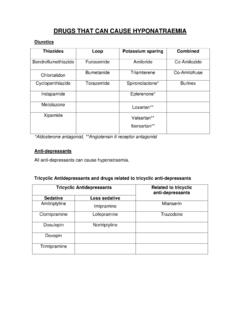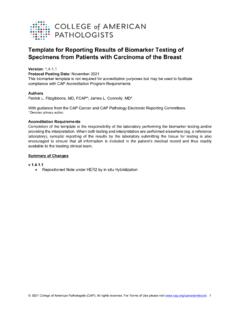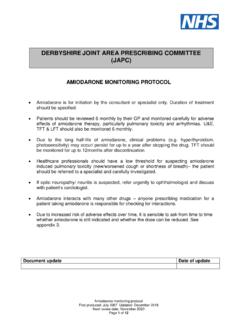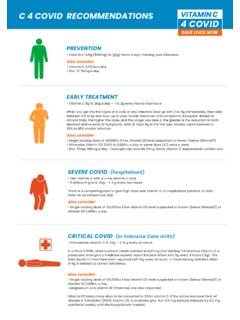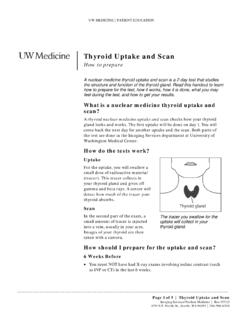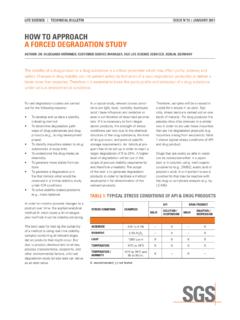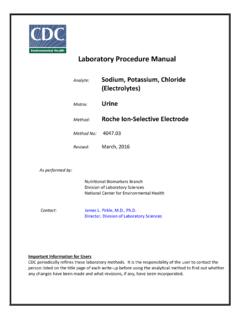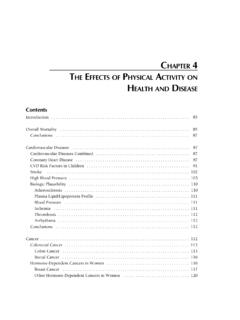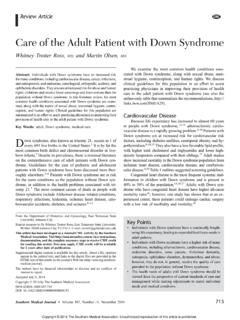Transcription of UK Guidelines for the Use of Thyroid Function Tests
1 Adapted Summary of UK Guidelines for the Use of Thyroid Function Tests (July 2006) Introduction The Use of Thyroid Function Tests Guidelines Development Group was formed in 2002 under the auspices of the Association for Clinical Biochemistry (ACB), the British Thyroid Association (BTA) and the British Thyroid Foundation (BTF). The purpose of the Guidelines is to encourage a greater understanding of Thyroid Function testing amongst all stakeholders with a view to the widespread adoption of harmonised good practice in the diagnosis and management of patients with Thyroid disorders. This summary is adapted from the July 2006 Guidelines .
2 Contents Indications for Thyroid Function testing Hypothyroidism Hyperthyroidism Indications for Thyroid Function testing Thyroid dysfunction is common. In the UK, the prevalence of spontaneous hypothyroidism is between 1% and 2%, and it is more common in older women and ten times more common in women than in men. Approximately 10% of subjects over 60-years old have serum TSH values above the normal range so called subclinical hypothyroidism . The prevalence of thyrotoxicosis in women is between and 2%, and it is also ten times more common in women than in men. The Normal Healthy Adult Population, Including the Elderly: The ageing UK population and the introduction of the General Medical Services contract are providing GPs with more opportunity to consider Thyroid dysfunction in the normal community, especially in elderly subjects with few or no symptoms of Thyroid disease.
3 The prevalence of unsuspected overt Thyroid disease is low, but a substantial proportion of subjects tested will have evidence of Thyroid dysfunction, usually subclinical hypothyroidism. For more information on the recommended follow-up of patients with subclinical hypothyroidism, please refer to the relevant section in the Hypothyroidism chapter. Screening for Thyroid dysfunction in a healthy adult population is not warranted. Case-finding in women at the menopause or if visiting a doctor in primary care with non-specific symptoms may be justified in view of the high prevalence of mild Thyroid failure. Hospital In-Patients: Isolated alterations in serum TSH concentrations (either slightly low mU/L or high 5-20 mU/L) occur in about 15% of such patients due to altered TSH secretion in response to non-thyroidal illness or drugs.
4 About 2-3% of hospitalized patients have serum TSH concentrations that are fully suppressed (< ) or significantly elevated (>20mU/L) but less than half will have an underlying Thyroid disorder. An accurate diagnosis can be achieved if clinical indications for measuring Thyroid Function exist. Routine testing of Thyroid Function in patients admitted acutely to hospital is not warranted unless specific clinical indications exist. Goitre and Thyroid Nodules: Testing of Thyroid Function should be performed as part of the routine assessment of all patients who present with a suspected goitre (diffuse, multi-nodular or single nodule) at presentation to detect clinically unapparent hypothyroidism or hyperthyroidism.
5 Serum TSH should be measured in all patients with suspected goitre. Atrial fibrillation, Hyperlipidaemia, Osteoporosis, Subfertility: Thyrotoxicosis is a recognised cause of atrial fibrillation and a potentially correctable cause of osteoporosis. Hypothyroidism is a recognised secondary cause of dyslipidaemia. Both thyrotoxicosis and hypothyroidism can cause menstrual abnormalities and subfertility. Patients with atrial fibrillation, dyslipidaemia, osteoporosis and subfertility should their Thyroid Function assessed by measurement of serum TSH at presentation. Patients with Diabetes: There is a high frequency of asymptomatic Thyroid dysfunction in unselected patients with type-1 diabetes.
6 Patients with type-1 diabetes should have a check of Thyroid Function included in their annual review. Patients with type-2 diabetes should have their Thyroid Function checked at diagnosis but routine annual Thyroid Function testing is not recommended. Women with Type 1 Diabetes: Women with type 1 diabetes are three-times more likely to develop postpartum Thyroid dysfunction. Women with type 1 diabetes should have TSH, FT4 and TPO antibody status checked pre-conception, at booking when pregnant and at 3 months post-partum. Past History of Post-partum Thyroiditis: Women with a past history of postpartum thyroiditis have a risk of long-term risk of permanent hypothyroidism and recurrence in subsequent pregnancies.
7 All women with a past history of postpartum thyroiditis should be offered an annual check of Thyroid Function and should also be screened prior to and at 6 to 8 weeks after future pregnancies. Patients Receiving Amiodarone and Lithium: Amiodarone contains 75mg iodine per 200mg tablet and is frequently associated with Thyroid dysfunction. Amiodarone-induced hyperthyroidism is particularly prevalent (10%) in areas of iodine-deficiency and in patients with underlying Thyroid disease. Amiodarone-associated hyperthyroidism should be diagnosed only if high circulating FT4 is associated with high or high/normal FT3 and undetectable TSH since even in euthyroid subjects amiodarone therapy often causes modest elevation in serum FT4 (and reduction in FT3) because of its effect on peripheral deiodination of T4 to T3.
8 A diagnosis of amiodarone-associated hyperthyroidism should prompt specialist referral since management may be complex and involve further investigations. Amiodarone-induced hypothyroidism is more common in iodine-replete communities (up to 20%) and related to the presence of Thyroid autoimmunity. Lithium use is associated with mild and overt hypothyroidism in up to 34% and 15% of patients respectively, and can appear abruptly even after many years of treatment. Lithium-associated thyrotoxicosis is rare and occurs mainly after long-term use. All patients on amiodarone therapy should have Thyroid Function tested before commencing treatment and then should be routinely monitored every 6 months thereafter whilst on treatment and up to 12 months after cessation of therapy.
9 Particular care is required in the diagnosis of hyperthyroidism in patients taking amiodarone. The measurement of TSH, FT4 and FT3 is required. All patients on lithium therapy should have Thyroid Function tested before commencing treatment and then should be routinely monitored every 6-12 months whilst on treatment. Post Neck Irradiation: The incidence of hypothyroidism after surgery, external radiation therapy of the neck, or both, in patients with head and neck cancer (including lymphoma) is as high as 50% within the first year after treatment. Thyroid Function should be tested every 12 months in patients treated by external irradiation to the neck in view of the risk of hypothyroidism.
10 Down s Syndrome & Tuner s Syndrome: The incidence of hypothyroidism in patients with Down s Syndrome or Tuner s Syndrome is high. All patients with Down Syndrome and Turner s Syndrome should have an annual check of Thyroid Function . Hypothyroidism PRIMARY HYPOTHYROIDISM Diagnosis: Hypothyroidism is associated with a number of classical symptoms and signs. Patients with severe hypothyroidism may exhibit several of these clinical features, however, many patients with milder forms of the disease exhibit few clinical features and some will exhibit none. This is especially true of the elderly. Many symptoms of hypothyroidism are not specific for the disease and therefore hypothyroidism cannot be diagnosed accurately on symptoms alone.

